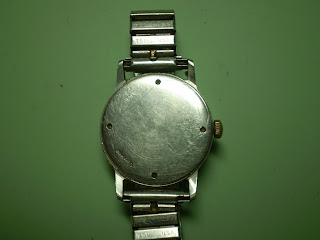When Elgin introduced the 8/0 Shockmasters, they made them in only Elgin and Elgin Deluxe grades. Perhaps they thought Lord Elgin owners wouldn't need shock protection? As usual for Elgin, a slight modification led to a whole new grade number. The Shockmaster version of the 554 became the 642, while the 555 became the 641. I have no idea why they flipped the numbering, so that the LOWER number had the HIGHER jewel count, but Elgin's grade numbers didn't always make sense!
Last week, I picked up an Elgin Shockmaster with a 15j 642, in a stainless steel case for about $22. The seller listed it as 'runs, but needs to be wound every few hours'. That boded well for the balance!
Here's the arrival and unwrapping...
The dial's a little grubby, and there's a radium burn the exact shape of the hour hand's lume window. The crystal is scratched and a little cloudy, and the case has the usual green and brown crud in all the nooks and crannies. But what do you expect after 62 years, for $22?

The case is one of Elgin's waterproof consumer cases. The 4-hole back is seen on a number of these. Earlier models came with wrench flats, while later models had the inlets that are common today. Once the back is opened, we see the movement - a 15 j 642, from 1951.
The first step in the restoration is to take the movement out of the case. To do this, the stem must first be removed: pull the crown to setting position, and unscrew the setting lever screw about 1 1/2 turns, and try to pull the stem out. If it doesn't come out, unscrew half a turn and try again. Continue until the stem comes out.

At this point you can remove the O-ring and the spacer ring. If you turn the watch over, the movement and case ring will generally come out.
Leaving the second hand in place, unscrew the dial foot screws a bit. All of Elgin's wrist watch movements introduced after 1935 have only 2 dial foot screws, though some earlier models have 3. Lift the dial and the second hand off.
Remove the hour wheel. To remove the cannon pinion, I grasp it from the side with tweezers, and gently lever/lift it off. If it refuses to budge, don't force it.

Now the movement is ready to tear down. That's in the next post.














Question about the dial screws. I have a Horizon-Panorama with a #724 movement, I am at a complete loss as to how the dial is removed, I see no foot screws in the side of the movement, nor the impingement-type screws on the back? Help please?
ReplyDeleteA number of Elgin's 13/0 movements used tension springs to hold the dial feet instead of dial foot screws. Lift gently, and it should come off. There are still 2 dial feet.
ReplyDeleteYou are correct! I carefully prised it off using 2 credit cards, no scratches, worked like a charm. Thank-you.
ReplyDelete